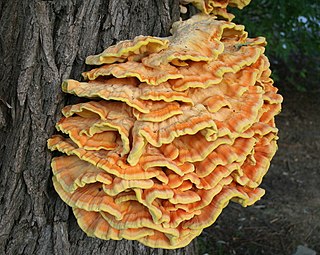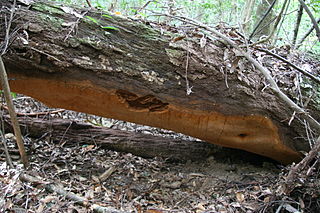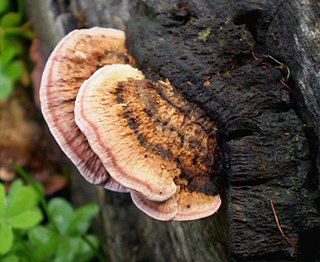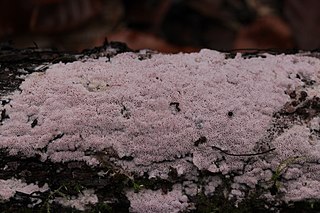
Laetiporus is a genus of edible mushrooms found throughout much of the world. Some species, especially Laetiporus sulphureus, are commonly known as sulphur shelf, chicken of the woods, the chicken mushroom, or the chicken fungus because it is often described as tasting like and having a texture similar to that of chicken meat.

Cui Jian is a Beijing-based Chinese singer-songwriter, trumpeter and guitarist. Affectionately called "Old Cui", he is credited with pioneering Chinese rock music. For this distinction he is often labeled the "Father of Chinese Rock".

Fistulina hepatica is an unusual bracket fungus classified in the Agaricales, that is commonly seen in Britain and the rest of Europe, but which can be found in North America, Australia, North Africa, and Southern Africa. As its name suggests, it looks remarkably similar to a slab of raw meat. It has been used as a meat substitute in the past, and can still be found in some French markets. It has a sour, slightly acidic taste. For eating, it must be collected young and it may be tough and need to be cooked for a long time.

Fistulina is a genus of fungi in the family Fistulinaceae. Species in the genus cause a brown rot of both dead and living hardwood trees.

He County or Hexian is a county in the east of Anhui Province, People's Republic of China, under the jurisdiction of Ma'anshan. It has a population of 650,000 and an area of 1,412 square kilometres (545 sq mi). The government of He County is located in Liyang Town.

Fomitopsis is a genus of more than 40 species of bracket fungi in the family Fomitopsidaceae.

"Nothing to My Name" is a 1986 Mandarin-language rock song by Cui Jian. It is widely considered Cui's most famous and most important work, and one of the most influential songs in the history of the People's Republic of China, both as a seminal point in the development of Chinese rock music and as a political sensation. The song was an unofficial anthem for Chinese youth and activists during the 1989 Tiananmen Square protests and massacre.

Phellinus ellipsoideus is a species of polypore fungus in the family Hymenochaetaceae, a specimen of which produced the largest fungal fruit body ever recorded. Found in China, the fruit bodies produced by the species are brown, woody basidiocarps that grow on dead wood, where the fungus feeds as a saprotroph. The basidiocarps are perennial, allowing them to grow very large under favourable circumstances. They are resupinate, measuring 30 centimetres (12 in) or more in length, though typically extending less than a centimetre from the surface of the wood. P. ellipsoideus produces distinct ellipsoidal spores, after which it is named, and unusual setae. These two features allow it to be readily differentiated microscopically from other, similar species. Chemical compounds isolated from the species include several steroidal compounds. These may have pharmacological applications, but further research is needed.

Rhodofomitopsis lilacinogilva is a species of bracket fungus in the family Fomitopsidaceae. Known primarily from Australia, it has also been recorded from Brazil and India. It is a white-rot fungus that grows on rotting eucalyptus wood. Its main identifying feature is the lilac colour of the pore surface on the underside of the fruit body.

Fibroporia is a genus of ten species of poroid crust fungi in the family Fomitopsidaceae. The genus contains species similar to those in genus Antrodia, but they are phylogenetically distinct.
Laetiporus zonatus is a species of polypore fungus in the family Fomitopsidaceae. It is found in southwestern China, where it grows on oak. The species was described as new to science in 2014 by Baokai Cui and Jie Song. The specific epithet zonatus refers to the concentric rings on the upper surface of the white to cream-colored fruit body. The fungus produces ellipsoid to pear-shaped (pyriform) or drop-shaped basidiospores that measure 5.8–7.2 by 4.3–5.5 μm. Molecular analysis of internal transcribed spacer DNA sequences indicate that L. zonatus is a unique lineage in the genus Laetiporus.
Laetiporus ailaoshanensis is a species of polypore fungus in the family Fomitopsidaceae. It is found in southwestern China, where it grows on Lithocarpus. The species was described as new to science in 2014 by Baokai Cui and Jie Song. Its fruit body has an orange-yellow to reddish-orange cap surface, with cream to buff pores on the cap underside. The fungus produces ovoid to ellipsoid basidiospores that measure 5.0–6.2 by 4.0–5.0 μm. Molecular analysis of internal transcribed spacer DNA sequences indicate that L. ailaoshanensis is a unique lineage in the genus Laetiporus.
Fibroporia albicans is a species of poroid crust fungus in the family Fomitopsidaceae. It causes a brown rot. The fungus was described in 2015 as a species new to science, based on collections made in Jiangxi and Xizang Provinces, China. It is one of five Fibroporia species recorded in China.
Megasporoporia minor is a species of crust fungus in the family Polyporaceae. Found in China, it was described as a new species in 2013 by mycologists Bao-Kai Cui and Hai-Jiao Li. The type was collected was made in Daweishan Forest Park, Yunnan, where it was found growing on a fallen angiosperm branch. It is distinguished from other species of Megasporoporia by its relatively small pores and small spores ; it is these features for which the fungus is named.
Fragiliporia is the sole genus in the fungus family Fragiliporiaceae. It contains the poroid crust fungus Fragiliporia fragilis, described as new to science by Chinese mycologists in 2014. The type specimen of this fungus was discovered growing on a rotting stump of alder in the Gaoligongshan National Nature Reserve in Yunnan. The specific epithet fragilis refers to the brittle fruit bodies of the fungus. Molecular phylogenetics shows that the fungus is in an isolated position in the Polyporales, distinct from the six previously identified clades in this order. In a later study (2017), Fragiliporia was recovered in a phylogenetically isolated position as sister to Candelabrochaete africana.
Ceriporia inflata is a species of crust fungus in the family Irpicaceae. It was described as new to science in 2013 by mycologists Bi-Si Jia and Bao-Kai Cui. The fungus is distinguished macroscopically from other Ceriporia species by its relatively large pores, and microscopically by its hyphae, which swell when KOH is applied; it is this latter feature for which the fungus is named. The type specimen of C. inflata was collected from Qiongzhong County, where it was found growing on rotten angiosperm wood. It has also been recorded from Fenyi County in Jiangxi.
Abundisporus mollissimus is a species of bracket fungus in the family Polyporaceae. This white rot fungus was described as new to science in 2015 by mycologists Bao-Kai Cui and Chang-Lin Zhao. The type was found fruiting on a fallen angiosperm trunk in Chengmai County ; it has also been found on a dead tree of Xanthophyllum hainanense. A. mollissimus is distinguished from other Abundisporus species by its effused-reflexed to pileate and soft fruit bodies, narrower skeletal hyphae, and spores that measure 4–4.5 by 3–3.5 μm.
Truncospora macrospora is a species of poroid fungus in the family Polyporaceae. It was described as new to science in 2013 by Chinese mycologists Bao-Kai Cui and Chang-Lin Zhao. The fungus, found in southwest China, is distinguished by its annual growth habit, and the distinct dark brownish crust on its caps. The semicircular caps measure about 1.5–3 cm (0.6–1.2 in) long, 2.5–3.5 cm (1.0–1.4 in) wide, and 1–4 cm (0.4–1.6 in) thick. Microscopic characteristics include its relatively large spores, measuring 16.5–19.5 by 8.0–9.5 μm, which have a strongly dextrinoid reaction. The type was collected in the Gaoligong Mountains at an altitude of 2,400 metres (7,900 ft), where it was found growing on a fallen angiosperm branch.

Ceriporia excelsa is a species of crust fungus in the family Irpicaceae. It is found in Europe and North America, where it typically grows on dead hardwood. It has also been recorded from China.
Ungulidaedalea is a fungal genus in the family Fomitopsidaceae. The genus was circumscribed by Chinese mycologists in 2016 to contain the single species Ungulidaedalea fragilis, a fungus that was described as new in 2014 with the name Fomitopsis fragilis. The holotype of this fungus was collected in Jianfengling Nature Reserve, in Ledong County (Hainan). The generic name Ungulidaedalea refers to the resemblance between this species and Daedalea, and also to the hoof-shaped (ungulate) form of the fruit body. Ungulidaedalea fragilis has rather fragile fruit bodies with a dark brown crust and large angular pores on the cap underside. Microscopic characteristics include its densely septated skeletal hyphae, and oblong-ellipsoid spores that measure 4–5.2 by 2.2–2.8 μm.









